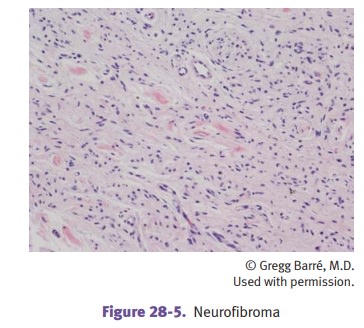Chapter: Pathology: Skeletal Muscle and Peripheral Nerve Pathology
Soft Tissue and Peripheral Nerve Tumors
SOFT TISSUE AND PERIPHERAL NERVE TUMORS
Lipoma is a benign adipose tissue tumor that most often arises in
subcutaneous tissue of trunk, neck, or proximal extremities. It is the most
common benign soft tissue tumor. The tumor is usually more of a cosmetic
problem than a medical one. Microscopically, it is composed of mature fat cells
but can contain other mesen-chymal elements.
Liposarcoma is a malignant adipose tissue tumor that most often arises in the
thigh or retroperitoneum. It is the most common adult sarcoma. It is
distinguished from lipoma by the presence of lipoblasts. Grossly, it tends to
be larger than lipoma, and the cut surface shows fibrous bands.
Microscopically, well-differentiated liposarcoma consists of mature fat with
varying numbers of hyperchromatic spindle cells and mul-tivacuolated
lipoblasts. Metastases are rare but retroperitoneal tumors tend to recur.
Dermatofibroma is a benign dermal spindle cell proliferation that most often
arises in the extremities. A small, red nodule is seen, which is tender and
mobile on exami-nation.
Fibromatosis is a non-neoplastic proliferative connective tissue disorder that
can his-tologically resemble a sarcoma. Fibrous tissue infiltrates muscle or
other tissue, and may cause a mass lesion. The cut surface is trabeculated.
Microscopically, bundles of fibroblasts and collagen are seen.
•
Superficial
fibromatoses arise from fascia or aponeuroses. Palmar fibroma-tosis is the most
common type. Penile fibromatosis is known as Peyronie’s disease.
•
Deep
fibromatoses (desmoids) occur in extraabdominal sites (children) and abdominal wall and extraabdominal sites
(adults). Abdominal desmoids often occur in women within a year of pregnancy.
They may also follow surgery or trauma. Intraabdominal fibromatosis is commonly
associated with Gardner syndrome.
Fibrosarcoma is a malignant fibrous tumor, commonly seen on
the thigh and upper limb. It may arise
spontaneously or after therapeutic/accidental irradiation. Micro-scopically,
there are uniform spindle cells with a “herringbone” pattern. Metastases are
hematogenous, often to the lung.

Undifferentiated pleomorphic sarcoma (previously known as
malignant fibrous his-tiocytoma) is a large multilobulated tumor seen in the
extremities and retroperito-neum of older adults. Microscopically, they may
have a storiform (cartwheel-like) pattern. They recur and metastasize.
Rhabdomyoma
Embryonal rhabdomyosarcoma
Leiomyoma is a benign smooth muscle tumor most often seen
in the uterus and gastrointestinal tract. Less often it is seen in skin, and
only rarely in deep soft tissue.
Leiomyosarcoma of soft tissue is less common
than its counterpart in the gastroin-testinal tract and uterus. In soft tissue,
it usually arises in the retroperitoneum of older women.
Grossly, the tumor is fleshy
and white with hemorrhage and necrosis. Microscopi-cally, the tumor nuclei are
blunt ended (“cigar-shaped”). Longitudinal striations can be seen with Masson
trichrome staining. The tumor is highly aggressive in the retroperitoneum, where
complete resection may not be possible.
Synovial sarcoma occurs in young adults. The
knee is a common location. The gross appearance is variable but calcification is
common. Microscopically, tumors may be biphasic (epithelial and spindle cells)
or monophasic (spindle cell or epithelial).
Benign
peripheral nerve sheath tumors
•
Schwannoma
is an
encapsulated nerve sheath tumor with alternating Antoni A and B areas. There is an associa-tion with
NF2.
•
Neurofibroma
is
nonencapsulated and may have a solitary, diffuse, or plexi-form pattern.
Microscopically, neoplastic cells are interspersed among wavy, loose or dense
collagen bundles. There is an association with NF1.

Malignant peripheral nerve sheath tumor may arise from neurofibromas
or de novo in a peripheral nerve. It typically occurs in
young adults in major nerve trunks (sciatic nerve, brachial plexus, and sacral
plexus). Microscopically, it resembles fibro-sarcoma. Recurrence and distant
metastases are common.
Related Topics